| |||||||
| Search Forums |
| Advanced Search |
| Go to Page... |
 |
| Search this Thread |  744,961 views |
| | #1 |
| Team-BHP Support  | Driven: 5th-gen Hyundai Elantra The Hyundai Elantra has been launched in India at a price of between Rs. 12.51 - 15.85 lakhs (ex-Delhi). What you'll like: • Fluidic styling makes the Elantra a true show-stopper • Spacious interiors. Top class quality too • Comfortable suspension. Especially nice within the city • Refined diesel & petrol motors mated to smooth 6 speed manual / automatic transmissions • Loaded with equipment. Ventilated seats, reversing camera, dual zone climate control etc. • Safety equipment includes 6 airbags, ESP, VSM, ABS & EBD What you won't: • 1.6L diesel engine can't match the outright punch of its 2.0L competitors • Uninspiring, conventional Automatic transmission. No dual-clutch technology here • Rear bench is optimised for 2. Thus, the Elantra is best used as a 4 seater • Ordinary expressway dynamics. Steering lacks feel at high speed • No MID, folding rear seat and sunroof The 2015 Facelift: • Link to Review  Last edited by GTO : 27th May 2015 at 09:44. Reason: Adding link to 2015 Facelift Review |
| |  (34)
Thanks (34)
Thanks
|
| The following 34 BHPians Thank tsk1979 for this useful post: | a*ed, bhaskaracs, Carcrazy60, CARDEEP, chinmaypillay, deetjohn, Digital Vampire, dr_TJ, Equus, Ford5, GTO, Guna, iliketurtles, manson, Monolithic, Mr_Bean, naveen.raju, noopster, one-77, RSR, S2!!!, Safari_Beast, scopriobharath, Sheel, SmartCat, surya_jindal, swiftnfurious, Technocrat, theexperthand, Turbo Head, Vasuki, vb-saan, vibbs, Yeldo |
| |
| | #2 |
| Team-BHP Support  | re: Driven: 5th-gen Hyundai Elantra 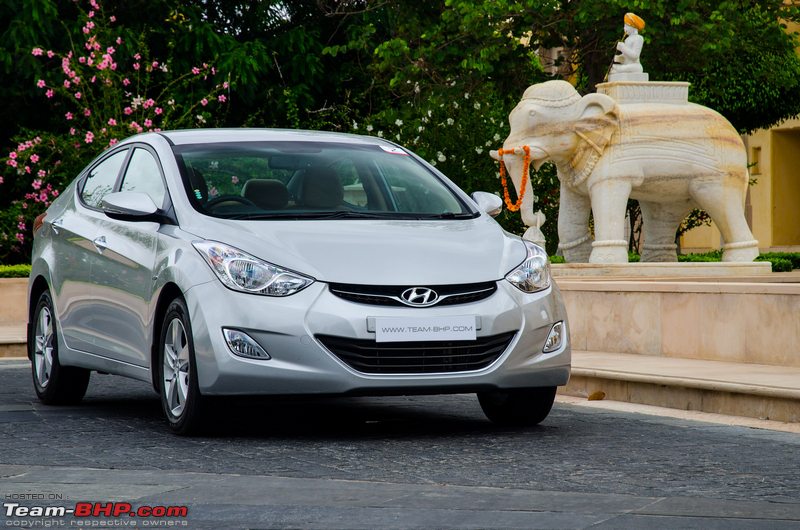 Hyundai's emergence from a bargain basement brand to that of a quality leader is commendable. Most of the Korean brand's cars today offer the best-in-class quality; models like the i20 & Verna also set the benchmark in terms of the feature list. As good as the product quality is however, the upper C segment has remained Hyundai's glass ceiling, just as it has been for Maruti & Tata. Every car they have launched in the Rs. 14 lakh segment and above just hasn't enjoyed success. The list runs long, starting with the Elantra launched in 2004, then the previous-gen Sonata, Tucson, Terracan and Santa Fe. Some haven't had enough appeal, while others were priced too high. A few cars were actually neat all-rounders (like the Sonata Diesel for instance), yet the brand & dull styling worked against them. 8 years ago, this is what the Elantra looked like:  Today, Hyundai's cars wear anything but dull clothes. The market has taken a huge liking for their fluidic design language. The 5th generation Elantra looks as if it's from a different planet altogether! When you compare the old with the new, the 2012 Elantra is not just 2 generations newer, but more like a reincarnation. The Fluidic front is the new face of Hyundai, now seen on almost all of the brand's cars...right from the Eon to the Sonata. I'd say Hyundai has nailed it on the design front. The paint quality is top notch, and the car feels precisely put together. There are a couple of unsightly panel gaps, but Hyundai has told us that these are pre-production cars, and final iterations should have everything sorted out (as it was with the Verna media drive cars). Specs Comparison: 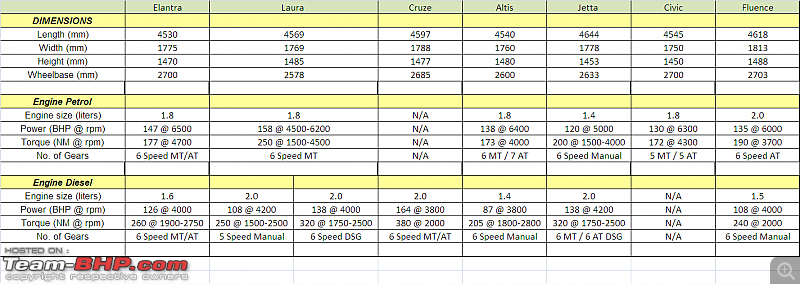 Price Comparison: 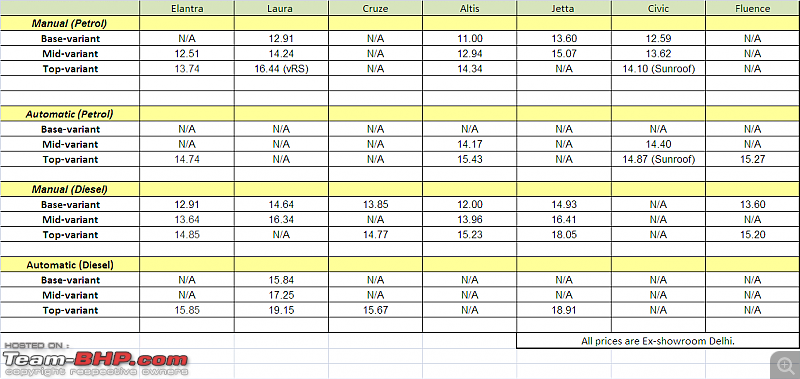 The Elantra looks stunning from the front 3 quarter angle: 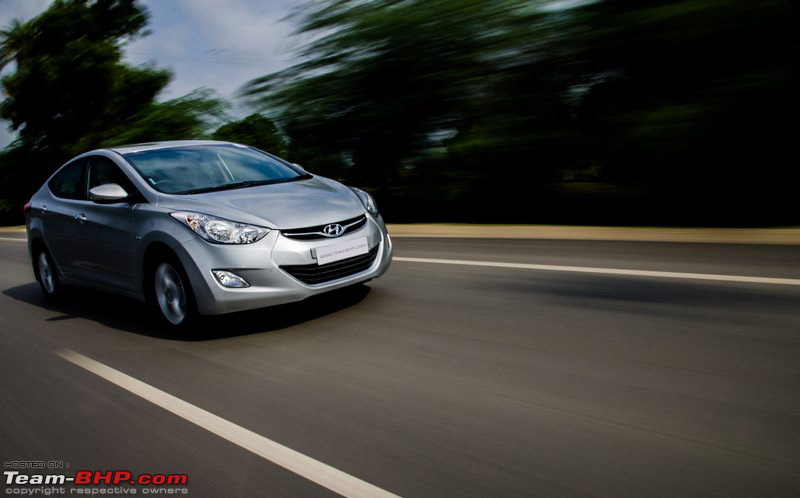 Sleek side profile. Design isn't too cab forward: 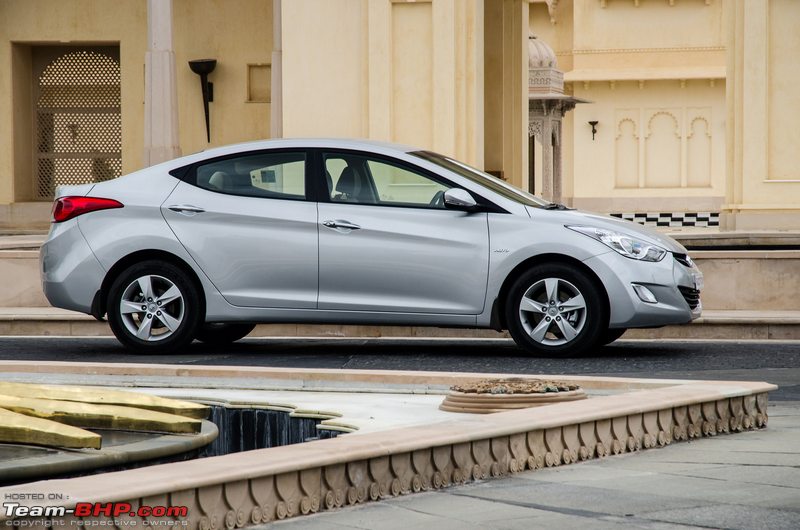 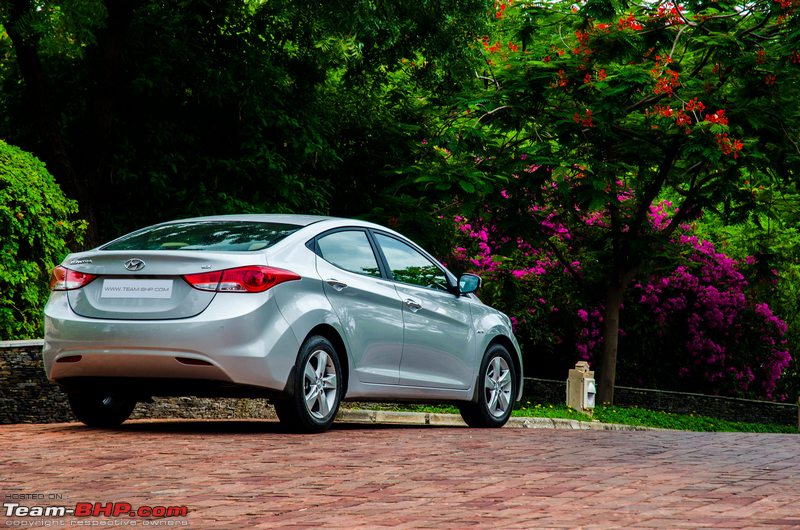 The big boot is a blemish on the Elantra's otherwise great looks. The rear looks bulky:  A sun-roof is conspicuous by its absence on the top variant. It would have rounded off the features list for a car of this segment: 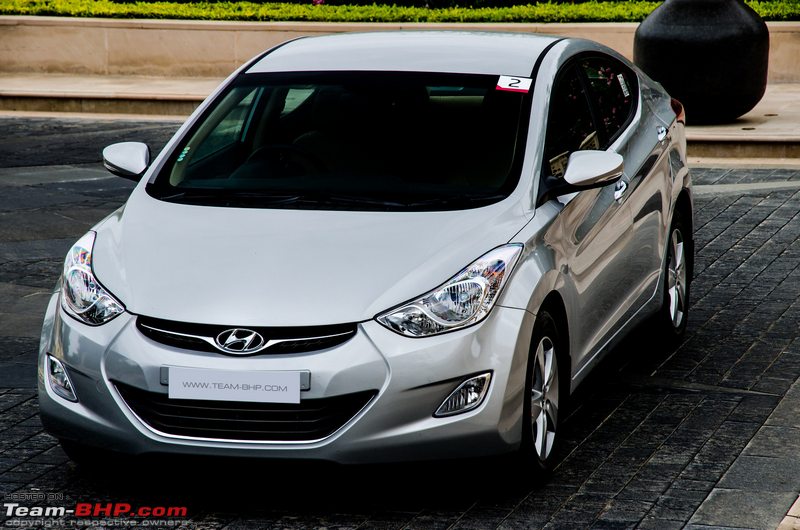 Twin-barrel halogen headlamps provide adequate illumination... 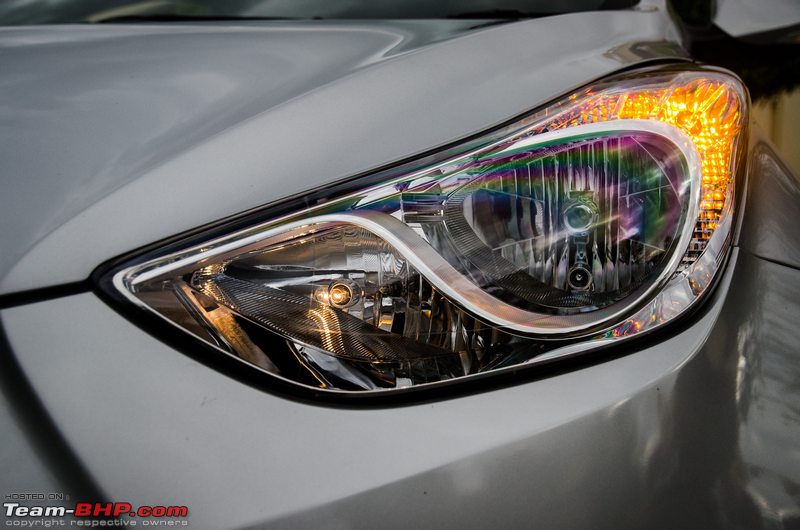 ...as seen here. Headlamp height adjustment moves only the low beam. High beam position is fixed:  Powerful Fog-lamps. They illuminate not only the front area, but also the side. This is particularly useful when driving on dimly lit roads: 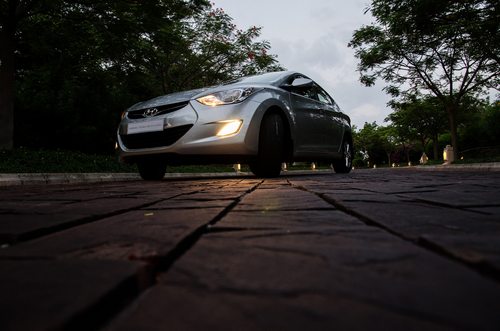 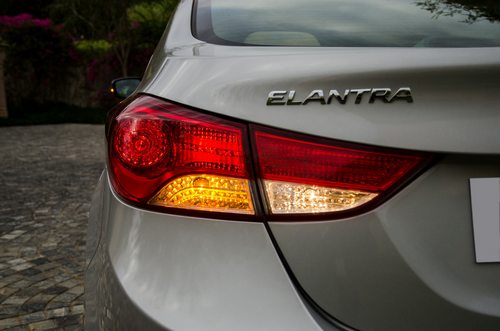 Request sensor allows true keyless entry: 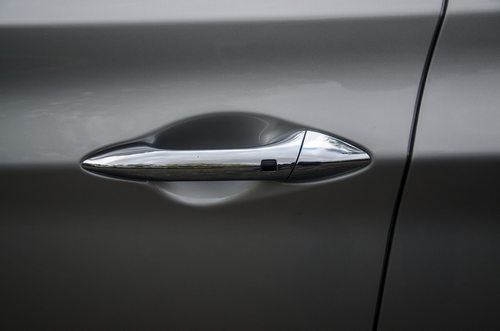 ORVM indicators wrap around all the way to the side:  Solar glass is claimed to be effective in blocking UV and IR. A boon when sunfilms have been declared illegal!! 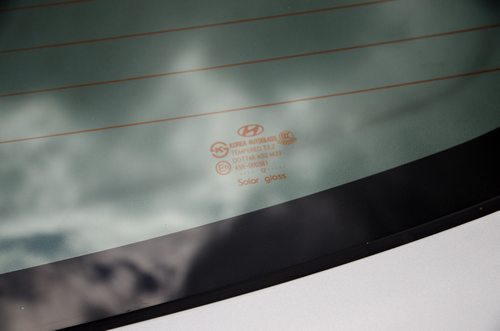 Disc brakes for all 4 wheels. Our test car wore (Korean) Nexen Silica Tyres: 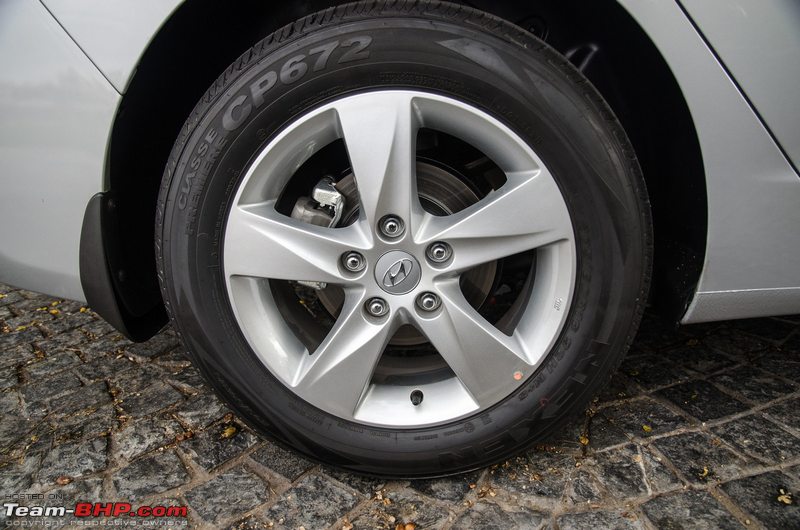 Tailpipe is barely visible from the back view. As is the case with most Hyundai sedans, the rear tow hook is in the center: 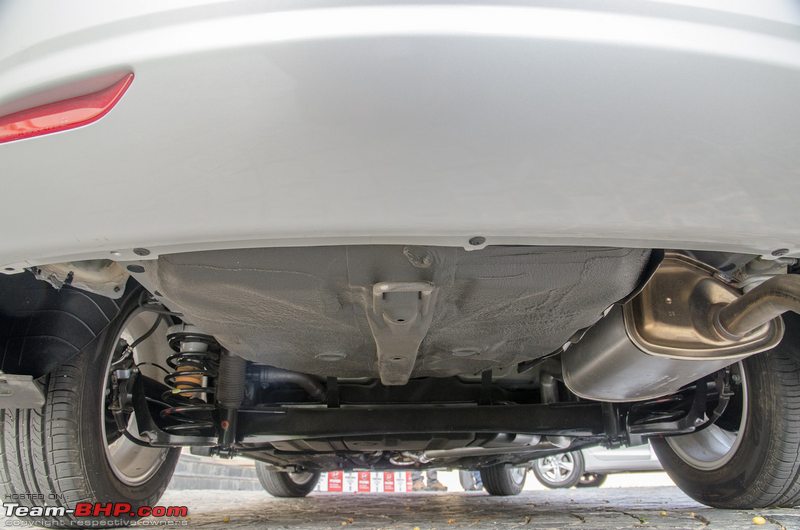 Rear camera neatly hidden from view. Next to the camera is the soft-touch button for opening the boot: 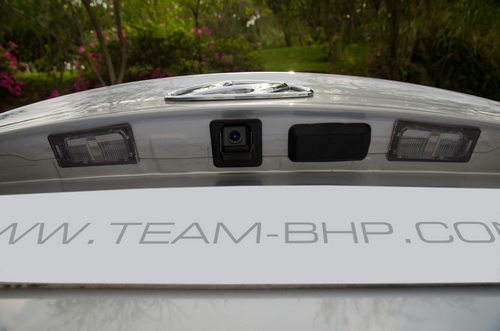 Rear window rolls down nearly to the bottom:  Be careful about the long, front overhangs. Easy to hit the kerb: 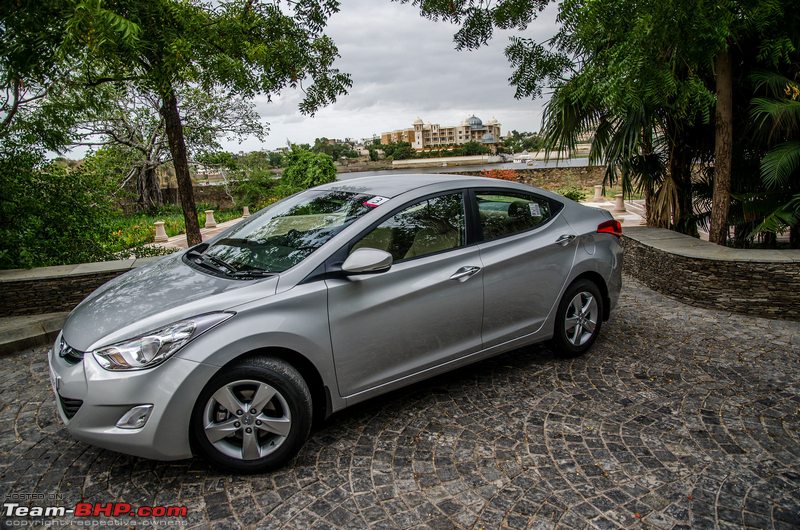 With the rest of the Fluidic sedan family:  A night shot. One of my personal favourites: 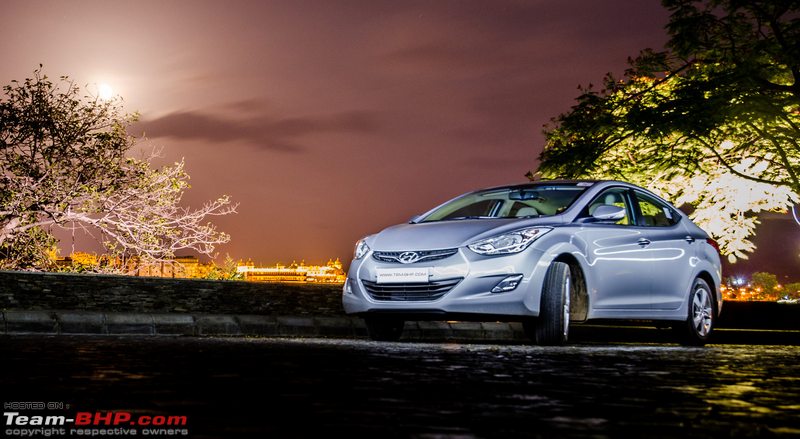 Last edited by GTO : 13th August 2012 at 15:17. Reason: Adding price comparo sheet |
| |  (50)
Thanks (50)
Thanks
|
| The following 50 BHPians Thank tsk1979 for this useful post: | a*ed, abhinavinc, Added_flavor, AlphaKilo, amitkb, amitwlele, Arun.K, arvi86, AVR, Batfreak, chinmaypillay, delta5, Digital Vampire, dkaile, dZired, GTO, Guna, guyfrmblr, iliketurtles, K a s h, manson, mh09ad5578, moralfibre, naveen.raju, ninjatalli, noopster, phamilyman, planet_rocker, PPS, prakhar1998, raj_5004, razor4077, ritzy, RSR, S2!!!, scopriobharath, SDP, Sheel, SmartCat, Swanand Inamdar, Swapnil4585, swiftnfurious, Technocrat, theMAG, Turbo Head, vibbs, Vid6639, wilful, Yeldo, _raVan_ |
| | #3 |
| Team-BHP Support  | re: Driven: 5th-gen Hyundai Elantra  The fluidic theme continues inside too. The dashboard is soft touch, while the dual-tone trim adds to the premium feel. Quality of material is really good and the interiors are fitting for a D segment sedan. Attention has been paid to detail. For example, look at the glove box. By tucking away the release lever to one corner, the fluidity of the dash is not broken. It's such attention to detail which adds a special touch to a car; Hyundai hasn't made any mistakes in this department. The central waterfall console has a digital clock with an external temperature readout at the top. Below that, the stereo has been tastefully integrated - following the curves on the console. Likewise for the A/C controls that are just below. The chunky steering wheel looks cluttered. There are buttons galore, and it takes a while to figure out a position where you can blow the horn without accidentally changing the volume or cruise control. The steering can be adjusted for reach and rake, both. The soft driver's seat gets 10-way electric adjustment. The seat's front and rear parts can be raised independently, ensuring ideal thigh support, and the lumbar settings do cover most postures. On the other hand, the front passenger has to contend with run of the mill manual adjustments for legroom and recline. That said, seat comfort is excellent. The wide cabin also ensures you don't elbow the front passenger when shifting gears. The driver's view is dominated by twin electroluminescent dials. Between them are two large information displays, which you would expect to function like an MID, but they give you access to vehicle settings and basic read-outs only. The upper blue-backlit display is for settings, while the lower display houses the gear info and fuel / temperature gauges. There is no Distance-to-Empty count or real time / average fuel economy display. This is quite a glaring omission in a car of this class. Nowadays, even hatchbacks come with fuel related information on their MIDs. Another shocker: the lower variants get a single trip meter. Yes, Hyundai has decided to make the trip meter a differentiating feature between lower and upper variants! MID and sunroof aside, Hyundai hasn't skimped on equipment levels. The Elantra gets dual-zone climate control and ventilated front seats. For those unfamiliar with this feature, ventilated seats slowly pump cold A/C air through small holes in the seat upholstery, thereby keeping the contact areas (between the passenger and seat) cool. I must say the feature is quite useful in drying your sweat-soaked back, a unique and ideal offering for this subcontinent. Due to relatively low ambient temperatures, I cannot comment much on the effectiveness of the A/C. We'll leave that to our ownership reports. Despite the fact that most Elantras will end up being chauffeur-driven, the rear seats don't get the ventilation feature. That's more to do with global usage patterns where this car is primarily self-driven. The rear does have a comfortably contoured bench with great support...nearly emulating bucket seats. This is one of the most comfortable rear seats to be on. Note that the Elantra's rear seat is best for two. The raised center, the stowed arm-rest and the rear A/C tower make it uncomfortable for a 5th passenger. The rear A/C has adjustable vents, albeit fan speed and temperature can't be controlled. Nifty little additions are the audio controls integrated into the rear armrest (giving you fairly versatile control of what's playing) as well as a 12v charging point. A well rounded offering, especially when compared to the cramped rear benches of the Laura & Cruze. I like the fact that Hyundai has not compromised on safety. The Elantra has received a 5 star rating in the USA NHTSA safety tests. The car gets up to 6 airbags (dual front, front-side & curtain). ABS with EBD and ESP are standard equipment. Chunky steering wheel is just the right size. Buttons are illuminated, although an overload of them means you'll inadvertently press one while sounding the horn. On a related note, the horn is awfully meek: 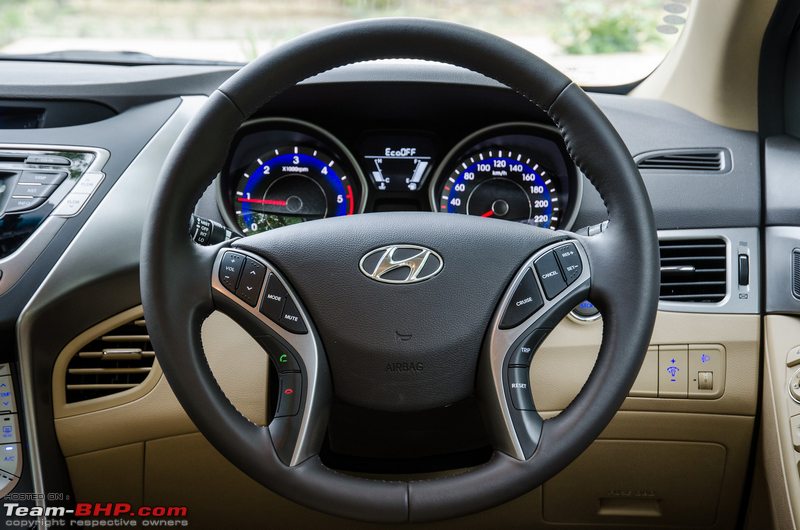 Electroluminescent dials stay illuminated during the day. Some programmable features; want to decide the speed at which the doors auto-lock? The follow-me-home headlamp delay? It's all in here:  The smart key can be kept in your pocket and forgotten about. You don't need to remove it to unlock or start the Elantra. Also visible here is the ventilated seat upholstery. Cool air passes out through these perforations: 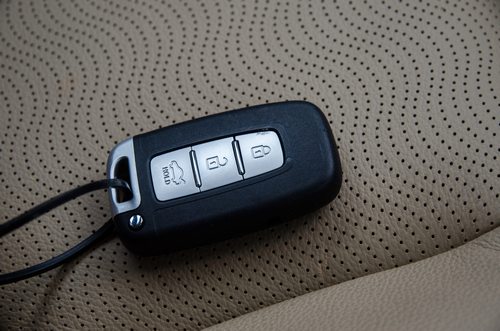 To the right is the engine start / stop button, ESP on / off, headlight level adjustment and console brightness adjustment. I am glad that the start / stop button isn't positioned towards the center, where a child or careless co-passenger could press it: 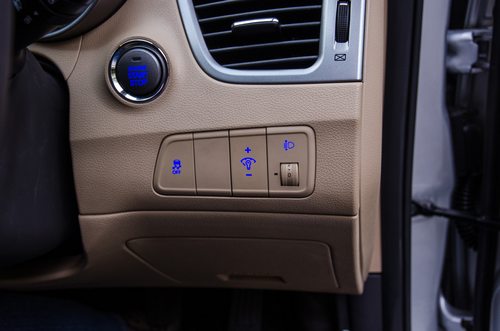 The wiper gets 5-speeds of intermittent action:  10-way electric adjustment on the driver's seat only. Passenger seat gets 4-way manual adjust:  The accelerator is organ type and the dead pedal is big. Even with large feet and bulky shoes, the pedals are comfortable to use:  Housed inside are the stereo AUX and USB inputs. Notice the chrome finish on the gear lever: 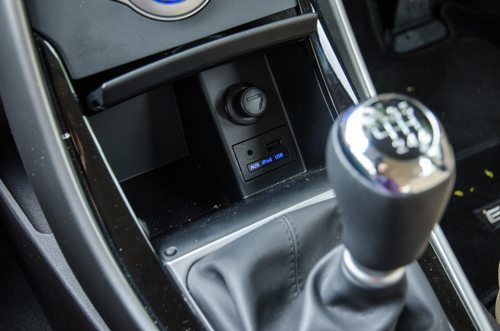 The simple looking AT lever. Design is similar to some German luxury cars we know:  Dual-zone climate control. Also notice the 3-speed buttons for each of the ventilated front seats:  Power window switches are illuminated, though only at the front. Electric-folding mirrors are standard. Only the driver gets one-touch up / down windows:  Storage spaces aplenty, with the center adjustable armrest revealing generous space inside:  The rear view mirror neatly integrates the reverse camera (though the outline doesn't move as you turn the steering). Parking sensor makes quite a racket if you get too close to an object. Reverse camera is usable even at night, thanks in no small part to the powerful reversing lamps:  Driver's rearward visibility is poor:  ORVMs are adequately sized. They get a "heating" function too:  Both, the driver and co-passenger, get illuminated vanity mirrors. No "auto-on" function though: 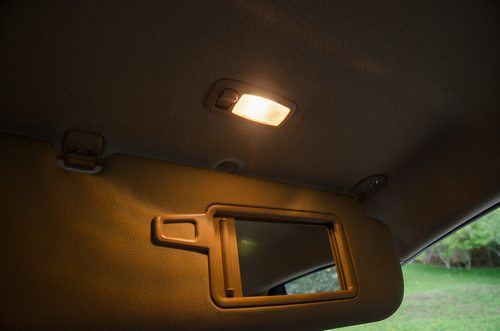 The side airbag. In all, the top variant gets 6 airbags:  Glove box is cooled, and quite big in size. That's a Galaxy Note BTW. I could fit a Nikon D7000 DSLR in here with ease. Downside? No illumination:  Excellent legroom at the rear. Maximum and minimum shown here:  With the driver's seat adjusted for my height (6'2"), I could easily sit behind without any issues:  Even with the seat fully pushed back, I can still manage to fit in:  Rear passengers get a comfortable armrest with inbuilt audio controls. The armrest has no cup-holders though:  12v charging point within the rear armrest compartment. Useful for juicing up your cellphone or laptop:  The bucket-like rear seats mean a raised hump in the center. A 5th passenger as tall as me would have his head rubbing against the roof:  Rear A/C vents don't gel with the rest of the interiors. Hyundai developed this specifically for India, and it shows. Rear blower eats into the 5th passenger's space. Notice the two seatback pockets:  The rear parcel tray has a steep angle, so you can forget about placing anything there:  Nice door trim at the rear. Door pockets have a bottle holder, but only for smaller bottles (not the 1 liter size). No puddle or warning lamps:  The boot is big, spacious and illuminated. You also get a safety net to hold loose items in place. No, the rear seat doesn't fold down:  The spare is a full-size alloy wheel. Tool kit is neatly packed onto the foam holder:  Last edited by GTO : 25th January 2013 at 13:10. |
| |  (22)
Thanks (22)
Thanks
|
| The following 22 BHPians Thank tsk1979 for this useful post: | a*ed, aboveallkaran, bkishore_77, Carb, dZired, goXrive, GTO, iliketurtles, manson, one-77, prakhar1998, racer_ash, RSR, S2!!!, scopriobharath, Sheel, SmartCat, Technocrat, Turbo Head, vibbs, Vid6639, Yeldo |
| | #4 |
| Team-BHP Support  | re: Driven: 5th-gen Hyundai Elantra The Elantra has two engine options; a 1.8L petrol and a 1.6L diesel. You can choose from a 6 speed manual or 6 speed automatic transmission for each engine, making it 4 engine-gearbox combinations in total. 1.6L Diesel  There isn't any doubt that the Elantra diesel will outsell the petrol by a huge margin. Except for the Toyota Altis' 1.4L engine & the Renault Fluence' 1.5L engine, D1 segment sedans usually have a 2.0L diesel under the hood. Hyundai has utilised the Verna's 1.6L diesel for the Elantra. This unit isn't as puny as the Altis', yet it lacks the sheer punch of the 2.0L competition. The engine pumps out 126 BHP (@ 4,000 rpm) and 260 Nm of torque (@ 1,900 - 2,750 rpm), thus running in the exact same tune as its smaller sibling. Unlike the Verna's 4-speed Automatic gearbox, the Elantra gets a 6-speed unit that helps to utilize the available power better. Switch on the Elantra diesel and, after the initial warm up, she settles into a nice thrum (as opposed to the clatter of a typical oil-burner). Inside the cabin, the Elantra is on the silent side. At times, it's difficult to tell that the car has a diesel engine under the hood. Only when you cross 3,000 rpm does some noise enter the cabin. Start driving and you'll realise that the motor is up to the job. There is some amount of turbo lag, but its far lesser than in the 148 BHP Chevrolet Cruze or Toyota Altis. This is a VGT engine (variable geometry turbo) with swirl control valves and hydraulic lash adjusters. While the lag is manageable, you will have to use the gearbox more than a VW Jetta (as an example) in the city. Like most other diesels, the action is between 2,000 – 4,000 rpm. The engine makes light work of urban commuting and should be more fuel efficient than its 2.0L competition too. On the open road, the engine has enough grunt to manage triple digit speeds without breaking into a sweat. For regular highway cruising and overtaking manoeuvres, power delivery is adequate. The Elantra's kerb weight is within a 100 kilos of the Verna, thus performance isn't much different. However, if you are a speed devil, this is not the car for you. Outright power & acceleration are average by D1 segment standards, and you simply can't compare its performance to that of the Chevrolet Cruze or VW Jetta which are in a different league altogether. Try to wring performance out of the Elantra and it will complain. The Elantra diesel is far more suited to the sedate driver than an enthusiast. The manual gearbox is slick shifting (save for the notchy reverse) and the clutch is light too. But there is no beating the convenience of a diesel AT. The Elantra AT is incredibly easy to drive within urban confines because of the light steering and compact turning radius. The AT gearbox upshifts early on. Shift quality is smooth and there are no unnecessary jerks. However, the gearbox has a lethargic response time when you need that sudden downshift for darting in and out of traffic gaps. No, this isn't a quick thinking dual-clutch gearbox. Like the engine, the gearbox is more suited to a relaxed driving style. For overtaking a truck at 100 kph, I actually preferred to gently press the accelerator, ride the torque curve and complete the overtaking manoeuvre in the same gear itself. If I needed to downshift, I'd move the gearlever into tip-tronic mode and prepare the car for overtaking by manually downshifting first. The Elantra Diesel AT can make for a relaxed long distance cruiser. At a 100 kph, the motor is spinning over at only 1,800 - 1,900 rpm. Hyundai has given the Elantra an 'ECO mode'. Switching the ECO mode on tells the gearbox to hold on to the highest gear for as long as possible, delaying down-shifts. 1.8L Petrol Air intake is beside the left headlamp. Near the windshield washer cap is a covered OBD port. A 2nd OBD port can be found inside the cabin, on the fuse box:  I had a chance to drive the Petrol engine for a very short distance, thus the following are only first impressions (and not a full review). This is an all-new 1.8L petrol engine. The motor is rated for 147 BHP (@ 6,500 rpm) and 177 Nm of peak torque (@ 4,700 rpm). The Elantra petrol is very refined and power delivery is fairly linear. The low rpm throttle response in the petrol is naturally better than the diesel Elantra, due to the absence of a turbo. Ride & Handling The Elantra's road behaviour is balanced, unlike the wobbly Verna that feels so boat-like at speed. No, the Elantra isn't a corner carver and doesn't have the outright poise of its European rivals. Still, for a Hyundai, the road manners are a giant leap ahead. Despite a suspension that is calibrated softly for comfort, the rear does not oscillate and neither does every road undulation make the car rock. At high speeds, the Elantra is sufficiently planted...the stability & composure are good enough for most drivers. The car does not jump about on typically Indian roads. Body roll is acceptably controlled, and the electric steering does tighten up at high speed. In terms of feel however, the steering simply isn't there. ESP (electronic stability program) is standard across the range, and it really works. I tried a couple of tests. First is the "highway cow" test; left tires on gravel, right side on tarmac and brakes squeezed. The Elantra behaved just fine, something I doubt the Verna is capable of. I did not try this with the ESP off, I suggest you don't either! The 2nd test I put the Elantra through was the gravel test. I made some violent lane change manoeuvres on a gravel track, and then used the brakes to see if the car would start to spin. Nope, she didn't. Again, a system which works as it should. Thanks to all the software & hardware, the Elantra's braking capability is very good. The tires also play their part well and offer excellent grip. I'm not too sure about the longevity of these soft tyres though. The suspension is well sorted for a comfortable low speed ride. Most of the bumps are swallowed, while sharp ones are acceptably damped. The Elantra's soft ride comfort is a huge advantage over its stiffly-sprung competitors. Importantly, high speed ride isn't as wallowy as the Verna. While the Europeans do have an edge here, the Elantra is sufficiently planted at 120 - 140 kph. The suspension goes about its work in a fairly quiet manner. The strength of the Elantra is that it rides well, has acceptable handling, does not bounce or buckle and has an electronic stability system which works as intended. The Elantra has brilliant NVH. The cabin is superbly insulated from engine, road & wind noise.  To activate "ECO" mode, you have to navigate through the settings. There isn't any separate, dedicated button:  Under-body protection provided, though only till the intercooler. The engine sump is left unprotected:  Disclaimer : Hyundai invited Team-BHP for the Elantra test-drive. They covered all the expenses for this driving event. Thanks to Rehaan and GTO for their help in constructing this review. Last edited by tsk1979 : 30th July 2012 at 13:18. |
| |  (84)
Thanks (84)
Thanks
|
| The following 84 BHPians Thank tsk1979 for this useful post: | .anshuman, 1self, a*ed, aeroamit, AlphaKilo, amartyasg, amitkb, anToNIcHeN, arvi86, ashpalio, Balaji31582, bblost, bhaskaracs, bkishore_77, BoneCollector, Carb, Carcrazy60, chinmaypillay, delta5, download2live, drchernish, dZired, fiat_tarun, FireFoot, goXrive, GTO, Guna, guyfrmblr, h.s.r, horabonny, ike, iliketurtles, K a s h, karlosdeville, kenprakash, kevintomin, kingofkings, lamborghini, Latheesh, Leoshashi, lurker, madhuperiasamy, Maky, manson, maxbhp, maximuzz, moralfibre, Motored Mindset, nalinsaxena23, naveen.raju, Nazaar25, noopster, one-77, petrolveins, phamilyman, pjbiju, PPS, prakasse, prakhar1998, pratik1992, Prof_Vijay, rednikhil, RSR, samsag12, SchumiFan, scopriobharath, shamik.bose, Sheel, SmartCat, smashnerd, sri2012, SunilM, sunny29584, Swanand Inamdar, Swapnil4585, Technocrat, Tejas@perioimpl, Turbo Head, vb-saan, vibbs, Vid6639, vredesbyrd, yogi1771, _raVan_ |
| | #5 |
| Team-BHP Support  | re: Driven: 5th-gen Hyundai Elantra Superb review Tanveer, and supported by amongst the best pictures ever seen in an official review. Rating this thread a well-deserved 5 stars. After reading your review, I feel that the Elantra Diesel AT is a top choice in the D1 segment, along with the Jetta. Reason : A Hyundai will work out far more reliable in the longer term than the Europeans. The Koreans have greatly closed the gap to the Japanese in long-term reliability. Hyundai might also offer its 5 year extended warranty on this car. Second, the Nissan Sunny taught me that every car in the house does NOT have to be an enthusiastic choice. The Sunny is just so light & effortless to drive in the city (compared to my other 3 enthusiast cars which can be a handful in bumper-to-bumper traffic). The Elantra Diesel AT also appears to be a breeze to live with in our congested urban conditions. I love the styling, space, rear seat comfort, interior quality and equipment level. The Verna didn’t really impress me because of its uncomfortable rear seat, and unusually weak expressway behaviour. If anyone wanted confirmation that Hyundai is now on par with Honda & Toyota, they need to compare the Elantra to the Corolla & Civic. Can't figure out why Hyundai badged it the Elantra though (considering the previous-gen Elantra was a dud in India). The car should have been named Avante, it's nameplate in Korea. Thanks for sharing! Last edited by GTO : 30th July 2012 at 12:50. |
| |  (13)
Thanks (13)
Thanks
|
| The following 13 BHPians Thank GTO for this useful post: | .anshuman, amit_2025, Balaji31582, Blow Horn Ok, delta5, Motored Mindset, Nazaar25, petrolveins, Prof_Vijay, RSR, Tgo, tsk1979, vibbs |
| | #6 |
| Team-BHP Support  | re: Driven: 5th-gen Hyundai Elantra This has to be the best iteration of the Fluidic design theme - it really has no bad angles. Hyundai has nailed the following aspects when it comes to selling cars - - Design - Engines - Interior Quality - Features - Price. - Reliability All the need to do now is hire from engineers from Ford Europe to get the car dynamics right. Toyota will have a serious adversary then. |
| |  (6)
Thanks (6)
Thanks
|
| The following 6 BHPians Thank SmartCat for this useful post: | amitkb, Karthik1100, LP640, phamilyman, Prof_Vijay, RSR |
| | #7 |
| Senior - BHPian | re: Driven: 5th-gen Hyundai Elantra Superb review TSK.  This new member of the fluidic family looks the most stunning amongst all of them. I quite liked the rear styling of the Elantra as compared to the other D1 segment sedans. The absence of sun roof and dual clutch technology are the only two limitations of this car IMO. Hope Hyundai prices it competitively. It surely can prove to be the segment leader as the civic is now growing old. Thanx a lot for the comprehensive review. BTW, that night shot of the elantra is simply outstanding and it is now my laptop wallpaper as well.  Last edited by dZired : 30th July 2012 at 12:46. Reason: typo |
| |  (1)
Thanks (1)
Thanks
|
| The following BHPian Thanks dZired for this useful post: | Prof_Vijay |
| | #8 |
| BHPian | re: Driven: 5th-gen Hyundai Elantra Fantastic review tsk. The pictures are simply awesome. I just love the looks of the Elantra. As smartcat put it, this is the best version of the fluidic theme. We need to wait to hear the pricing. Hyundai has provided a strong alternative now to potential D segment consumers. I am sure there will be a few Verna customers upgrading to the elantra as well. No MID seems to be a glaring miss. Also the rear seat being more of a 2 seater is also disappointing. I will surely consider this when I look at Sedans in the D segment. My wife already is looking at an AT Diesel  Last edited by nurni76 : 30th July 2012 at 12:50. |
| |  (1)
Thanks (1)
Thanks
|
| The following BHPian Thanks nurni76 for this useful post: | Prof_Vijay |
| | #9 |
| BHPian Join Date: Nov 2006 Location: Chandigarh
Posts: 102
Thanked: 65 Times
| re: Driven: 5th-gen Hyundai Elantra Amazing review. This will definitely be a car to be reckoned with. They re offering just so much technology and comfort at such a great price. I think this Elantra will once again leave the D1 segment wide open |
| |  ()
Thanks ()
Thanks
|
| | #10 | |
| Senior - BHPian | re: Driven: 5th-gen Hyundai Elantra Fantastic review tanveer, the dials look absolutely drool. Now the handling part Quote:
| |
| |  (1)
Thanks (1)
Thanks
|
| The following BHPian Thanks rjstyles69 for this useful post: | Prof_Vijay |
| | #11 |
| BHPian Join Date: Jun 2007 Location: Pune
Posts: 371
Thanked: 245 Times
| re: Driven: 5th-gen Hyundai Elantra Brilliant photos of a brilliant looking vehicle. And a great review. Can you give some more information on the petrol's power and feel during your short drive? Is it a good performer in a straight line? |
| |  ()
Thanks ()
Thanks
|
| |
| | #12 |
| Team-BHP Support  Join Date: May 2004 Location: Bangalore
Posts: 20,383
Thanked: 17,293 Times
| re: Driven: 5th-gen Hyundai Elantra Excellent captures and super write up. I feel the "fluidic" design being carried forward is becoming a bore  though i like this one the best. Front quarter it looks close to the Civic?? but much more handsome i say. As far as the performance goes, i hate Hyundai's for the way they handle and i guess its being corrected a lil bit with this one. though i like this one the best. Front quarter it looks close to the Civic?? but much more handsome i say. As far as the performance goes, i hate Hyundai's for the way they handle and i guess its being corrected a lil bit with this one.But as GTO said it really doesn't matter what the enthusiast feels for numbers to rake in. General junta would be more than happy to have a good looking, decently performing easy to live with sedan more than anything else. Lets see the sales figures, should rake in decent numbers. |
| |  (1)
Thanks (1)
Thanks
|
| The following BHPian Thanks Jaggu for this useful post: | Motored Mindset |
| | #13 |
| Senior - BHPian | re: Driven: 5th-gen Hyundai Elantra Superb Review Tanveer and perhaps one of the best set of pictures that our forum has seen on an official test drive report. Hyundai has taken the fluidic design fluidly from the Verna to Elantra and now Elantra looks pretty contemprary and both exterior and interior seem to have a very upmarket feel. However, the highway manners seem carried forward from the Verna to Elantra. Just curious to know if both are similarly uninspiring on highway manners or Elantra is tad bit better? Rating a well deserved 5*'s |
| |  (1)
Thanks (1)
Thanks
|
| The following BHPian Thanks mobike008 for this useful post: | Motored Mindset |
| | #14 |
| Distinguished - BHPian  | re: Driven: 5th-gen Hyundai Elantra Good looking rework there. I know its a design philosophy, fluidic, and its supposed to filter to all their vehicles, but is it just me, or do all the hyundai sedans have started becoming indistinguishable at a glance? |
| |  ()
Thanks ()
Thanks
|
| | #15 |
| BHPian Join Date: Jul 2010 Location: Mumbai
Posts: 692
Thanked: 121 Times
| re: Driven: 5th-gen Hyundai Elantra Excellent review. The pictures make the Elantra look even prettier. Top class stuff there. Its hard to differentiate the Verna from the Elantra at first glance. They are so identical. The fluidic design is fine (carried over too far now by Hyundai) but the rear passenger roof slope seems very steep. I wonder how comfortable tall passengers would be at the back, now that it looks like its a car ideally suited for 4. Same engine as the Verna - that is a tad disappointing. Why should someone consider the Elantra over the Verna? Handling and ride don't seem much different from the Verna either. The interiors are excellent compared to Civic or Altis. The gizmo list is a long one and impressive. Hyundai seems to get this aspect bang on with all their launches. Its Toyota/Honda that have to do catching up with Hyundai now in this area. Like already mentioned, the enthusiasts will prefer the Cruze or Jetta over the Elantra which is more suited for the chauffeur driven. Last edited by fuel_addict : 30th July 2012 at 12:55. |
| |  ()
Thanks ()
Thanks
|
 |

